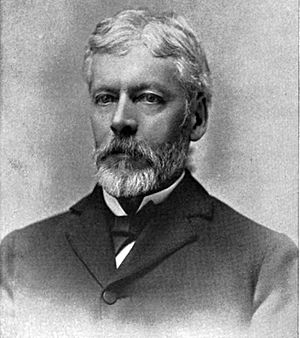Thomas Lamb Eliot facts for kids
Quick facts for kids
Thomas Lamb Eliot
|
|
|---|---|
 |
|
| Born | October 13, 1841 |
| Died | April 28, 1936 (aged 94) |
| Nationality | American |
| Citizenship | U.S. |
| Education | Washington University in St. Louis (1862, 1866) Harvard Divinity School (1865) |
| Occupation | Minister |
| Known for | church minister, serving the community |
| Spouse(s) | Henrietta Robins Mack |
| Parent(s) | William Greenleaf Eliot, Abigail Adams Cranch |
Thomas Lamb Eliot (born October 13, 1841 – died April 28, 1936) was an important person in the early history of Oregon. He was a minister, which means he led a church. He also helped start many important organizations in Portland, Oregon. These included the Portland Children's Home, the Oregon Humane Society, and the Library Association. He is best known for founding Reed College, a famous school.
Contents
Thomas Eliot's Early Life and School
Thomas Lamb Eliot was born in St. Louis, Missouri. His father, William Greenleaf Eliot, was also a minister. Thomas had trouble with his eyes, which made it hard for him to study.
To try and help his eyes, he took a long ship journey around Cape Horn to California in 1860. The trip didn't fix his eyesight. When he returned, he often had to have his school books read aloud to him.
School and Military Service
Thomas Eliot was part of the first group of students to graduate from Washington University in St. Louis in 1862. His father had helped start this university.
During the American Civil War, Eliot joined the Union Army. He was part of the Home Guard in Missouri, which meant he served only within the state. He didn't fight in any major battles.
After graduating, he worked at a mission house for poor people in St. Louis. He also studied to become a minister with his father.
Marriage and Further Education
On November 28, 1865, Thomas Eliot married Henrietta Robins Mack from St. Louis.
He then went to Harvard Divinity School. Even with his poor eyesight, he finished two years of study in just one year! In 1866, he earned a Master of Arts degree from Washington University.
Thomas Eliot's Ministry Work
Before moving to Oregon, Eliot worked as a minister in Louisville, Kentucky. He also helped out at a church in New Orleans for a few weeks at a time.
Moving to Oregon
In 1867, several churches asked Eliot to be their minister. He chose the offer from the First Unitarian Church in Portland, Oregon. He had always wanted to live in the Pacific Northwest.
He moved to Portland with his wife, Henrietta, and their baby son. They traveled through New York and Panama to get there.
By 1869, Eliot was holding extra church services each month. He visited places like the Insane Asylum, the County Jail, and the County Farm to help people there. He even held services in a saloon sometimes! People said he quickly became Portland's most important religious leader.
Eliot was also the only minister to welcome Abigail Scott Duniway, a famous supporter of women's rights, when she came to Portland.
Helping the Community in Portland
Thomas Eliot played a huge role in building up Portland's community and culture. He helped create and guide many important public groups in the city. One historian said he had a hand in almost every major public organization.
Founding Important Organizations
Eliot helped start the First Unitarian Church of Portland, the Oregon Humane Society (which helps animals), and the Boys & Girls Aid Society (which helps children). He worked to make conditions better in the county jail. He also helped orphans, the poor, and people with mental illness.
He strongly supported public schools and the public library. He also believed in women's right to vote.
Leading Cultural Institutions
Eliot was a board member for the Portland Art Association and the Library Association of Portland. He helped these groups lead to the creation of the Portland Art Museum and the Portland Public Library (which is now called the Multnomah County Library).
Founding Reed College
One of his biggest achievements was founding Reed College. When the college opened in 1911, Eliot became the head of its board of trustees. He served in this role until 1924. In 1935, the arts and sciences building at Reed College was named after him to honor his hard work and dedication to the school.

